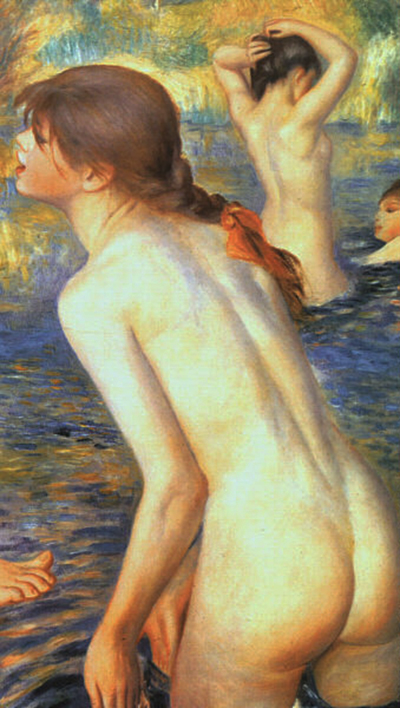One of Renoir's final works, The Bathers II took the artist almost 3 years of slaving and labouring to create
Following his death in December of 1919, Renoir's three sons gifted the painting to the State in 1923 and displayed in the Musée d'Orsay in Paris where it remains to this day.
The title refers to the five female bathers enjoying the water, three of them washing each other in the background on the right meanwhile two models lie together in the foreground of the image. It is interesting to note that Renoir used a real life model as one muse for his work.
The woman, Andrée Madeleine Heuschling (1900- 1979), was a favourite model of Renoir's and appeared in other pieces of his including 'Blonde à la rose' from 1915-1917.
Hessling, as she was more commonly known, later married Renoir's second born son, Jean Renoir (1894- 1979), in 1920 but divorced ten years later. Both partners were influential in the world of film with Hessing as an actress and the younger Renoir as an Academy Award winning director, producer and writer.
In order to create a peaceful and eternal scene, Renoir removed any references or allusions to the real world and desired to illustrate a beautiful and timeless scene of nature.
Despite this, many believe that the verdant imagery in the background is that of the painter's own garden from his manor in Cagnes sur Mer in the South of France. The Mediterranean terrain was to evoke impressions of Greek and Roman mythology. Renoir wished to depict one of the paradises of the gods, free from the constraints of time and space.
Renoir drew inspiration for the piece from the open air nude works from artists such as Titian and Rubens who were greatly admired by Renoir himself. The realistic and full scale models of women against the glimmering landscape, as well as the use of dry paint are homages to traditional 17th and 18th century French paintings. Thomas Gainsborough was also significant in this genre, with famous paintings such as The Blue Boy and Mr and Mrs Andrews.
Despite the obvious skill and beauty visible in the art, Renoir faced much criticism and opinionated feedback. Many critics were unhappy with the new style Renoir had begun to experiment with, and others attacked his depiction of the models. In particular, the arms and legs were considered too large, the flesh to be soft and flabby and finally the pink hue of all models to be simply poor. Having spend nearly three years to complete, Renoir vowed to never again to commit such time and effort to a single work.




